INVESTIGATION: Eating and learning — school feeding entices pupils to Anambra classrooms
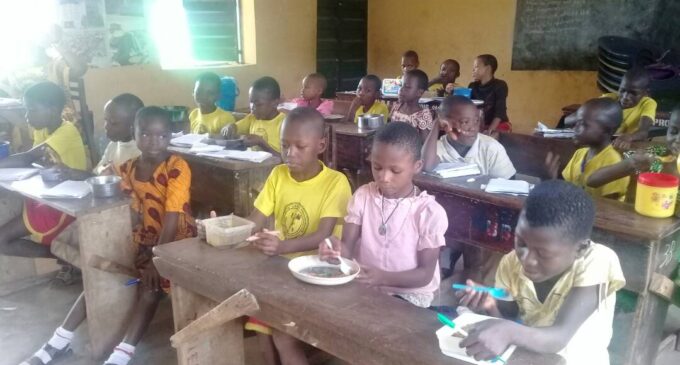
If there is a state where the national home grown school feeding (NHGSF) programme is producing encouraging outcomes, Anambra is it. But as CHINEDU ASADU finds out in a tour of primary schools across five local governments, there are still hitches as well as food for thought for the authorities
STORY HIGHLIGHTS
- Caterers were selected from the local community through an open application process
- They were trained on how to carry out their duties effectively
- The programme currently targets pupils from primary one to three classes
- The general food menu consists of porridge yam for Monday, jollof rice for Tuesday, beans with plantain/potato, Wednesday, okpa, Thursday and moi moi with egg for Friday
- ‘Over N600 million’ released in the state with 1,009 cooks employed so far
Located at the far end of Obosi Central School in Idemili north local government area, Anambra state, is the classroom block housing the pupils of primary 2A. There are 21 of them seated in the class and, according to their teacher, each averages a class attendance of 90 per cent.
So what’s the big deal about being punctual to class? Prior to December 2016, when the federal government introduced the national home grown school feeding (NHGSF) programme in the state, at least two out of the 20 of them would miss school on daily basis with reasons ranging from inability to pay school fees to ill-health.
But since they started being fed during school hours, the sicknesses and all other old things have passed away; new things have now begun in their academic endeavours.
“Even if you instruct them not to come because they did not pay their school fee, you see them still coming every day and more importantly, not forgetting to bring their plates along with them,” Joy Okafor, their teacher, says.
This is not peculiar to the pupils in the school alone as checks revealed that the school feeding programme has, among other things, brought great joy in the lives of pupils in Anambra.
When TheCable visited some of the LGAs in Anambra, there was evidence that the programme has indeed commenced in the government schools. But what are the things entailed in the running of the N500 billion social investment programme?
STOP-START: PAY BEFORE SERVICE
Checks revealed that the number of days in a month in which the pupils are fed varies from school to school. While the caterers in most of the schools cook for the children for up to twenty days or more, others cook for as low as two weeks “till whenever the next tranche of payment is made”. Some others however cook on a daily basis.
In Obosi Central School, for instance, Obi Anthonia, one of the caterers, revealed the payment usually made to them is just for ten days.
“As they are sending the money, they are stipulating the specific number of days the money will last,” she added.
But in some other schools such as Model Primary School, Nkwo Nnewi, in Nnewi north, one of the caterers in the school said she usually cooks for 20 days while the one at Ezi Awka Community Primary School, Awka, claims she cooks “every day except on public holidays”.
Even nursery pupils are fed in some schools
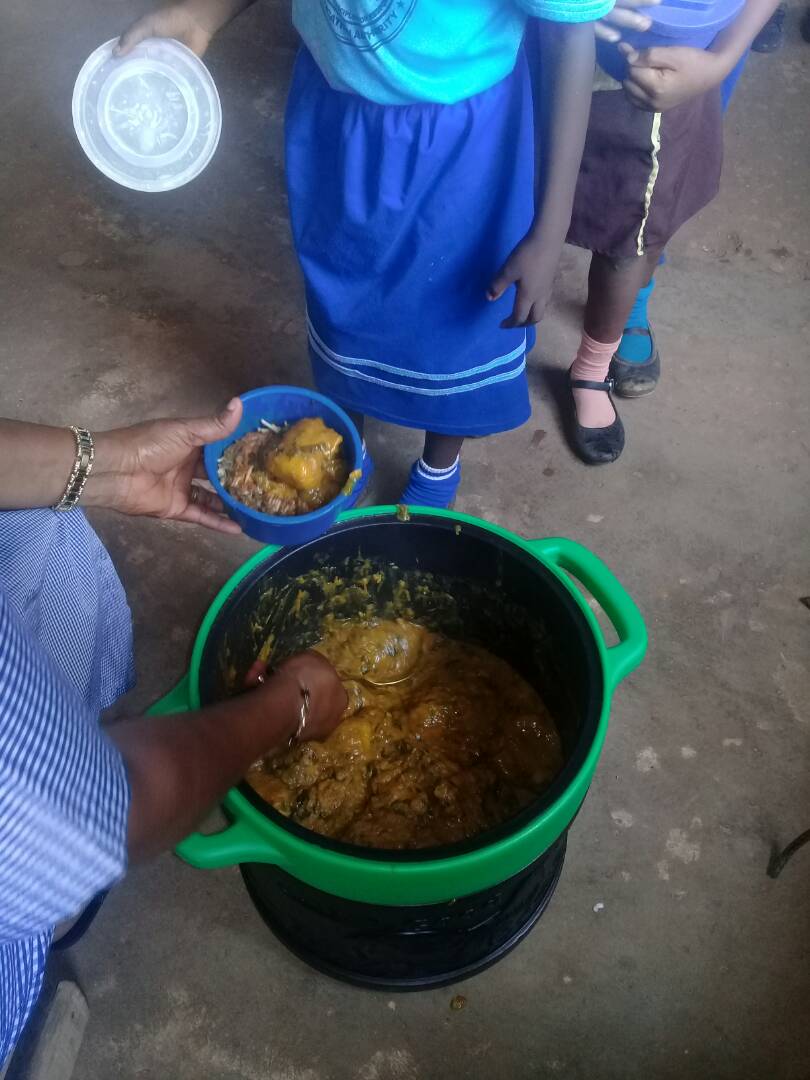
Serving yam porridge at Obosi Central School
In what looks like a generous gesture, some of the schools visited extended the feeding to the nursery Sschool pupils but still at same amount budgeted for feeding only the pupils in nursery one to three.
Although such schools said the kids in nursery classes are fed only on occasions where the food is remaining, checks revealed that for the extra stomachs to be added, some sacrifices have to be made at the expense of the original beneficiaries. It was discovered that in most cases, the ration shared to the primary one to three pupils is reduced hence making the quantity much smaller than what it should be.
This notwithstanding, some of them, like in the case of the caterer at Umuota Nursery and Primary School, Idemili north, believes there is little or nothing she can do about the plight of the nursery pupils.
“The money is not even enough for those it is meant for let alone adding more pupils. The best thing is for the government to increase the money being paid so as to accommodate them,” she said.
In most schools, quality and quantity are a sham
While the food in few of the schools is little above average in quality and quantity, others are nothing close to being nutritious and enough for the students. In fact, of the five schools visited, only in one school could the food pass as ‘fair’. In other cases, it is either the food is lacking in needed condiments or the share for each pupil would rather aggravate hunger instead of keeping it off.
In Obosi Central School, Joy Okafor, the health teacher who tastes the food before it is being shared, admits that although “the nutrient could pass as fair… the fish they usually put is just for the sake of it.”
Helen Ejimuna, a caterer in the school, however says she can’t cook something she won’t give her child to eat for others.
“At worst, wherever my money stops, I will not cook, but the food will always be rich in nutrient,” she maintains.
And it truly is. The aroma of the porridge yam in the day’s menu envelops the entire class even as a closer look confirmed how “garnished” it is. Garnished, not with all sorts of condiments fish but relatively, compared to the beans served at Ezi Awka Community Primary School the day TheCable visited the school.
Like drops of water, the sharer (one of the school teachers) drops just a spoonful of beans in each plate brought forward by the pupils in a queue while the school caterer stands by her side, assisting.
Ifeoma Ndubuisi, the health teacher monitoring the process, would later say the food is that small to be able to reach the nursery pupils.
“It is usually not good when they salivate, looking at us give food to others,” she said, “so I discussed with the headmistress and we agreed it would be nice to reduce the ration a bit for those other ones so the food can also reach them. But as for okpa and moi moi which are counted, we don’t give them.”
The caterer in the school further gives surprising details of how she manages to cook the food for the pupils: “For rice, I buy N350 price of fish into five but for beans, I use three pieces of N250 worth of fish” – for 106 pupils!
No one talks about fish in other meals; in the school it’s exclusively for days of rice and beans as well.
Hope Igbokwe, a caterer at Model Primary School Nkwor Nnewi, however blames the government for the low quality of the food.
“They say good food na money make am. If you want the quality to improve, then increase the budget,” she added.
More enrolment, Better performance too
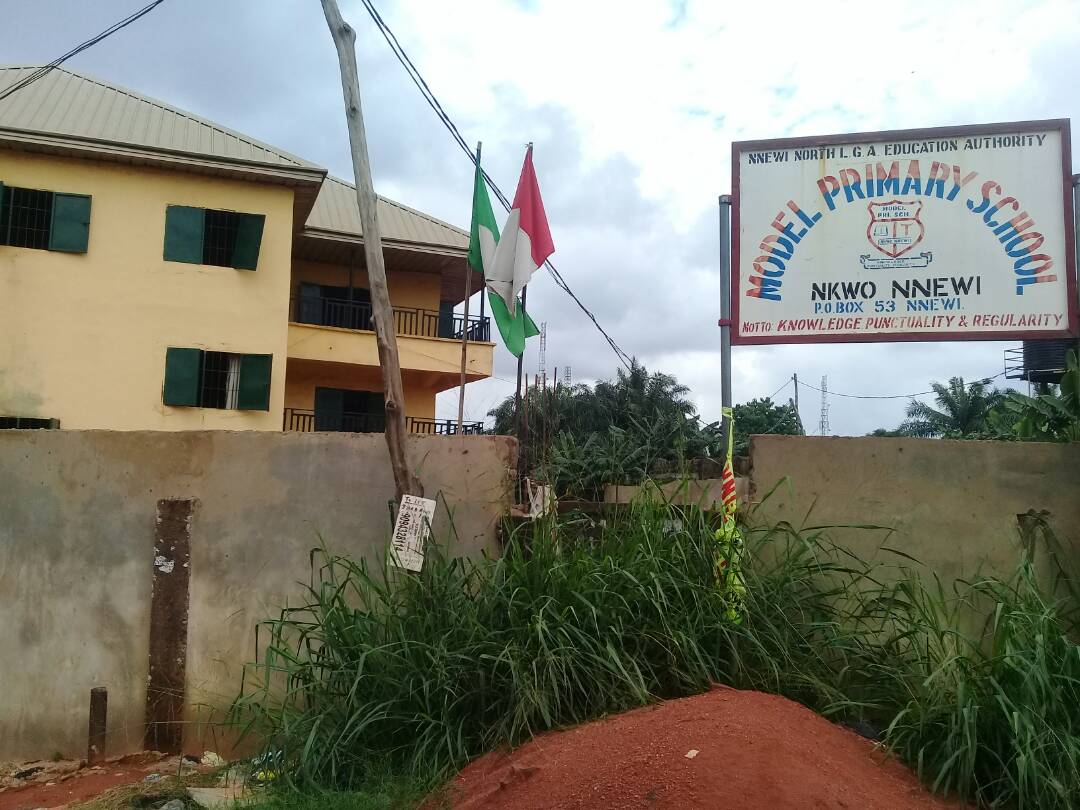
Model Primary School, Nkwo Nnewi… enrolment improving
One of the cardinal objectives of the school feeding programme is to increase school enrolment but how far has this been achieved in Anambra? Checks around the schools revealed that between December 2016 when the programme started in the state and now, there has been an increase in the number of pupils being enrolled into schools.
At Umuota Nursery and Primary School, there was a slight increase in the number of pupils being enrolled into affected classes, from 160 to 167, judging from the number being fed by the caterer.
Although the headmistress declined comments, teachers who spoke to TheCable on the condition of anonymity confirmed that the average performance in some of the primary one to three classes has increased – “but just a little above what it used to be”, according to one of the teachers.
“It was only two persons that failed in my class last term,” she said, adding “unlike previous terms where it used to be double that number or even more.”
The situation is a bit better at Iyiagu Primary School, Iyiagu Awka, where the school authority revealed that 17 additional pupils joined primary one to three classes, thereby taking their total number from 89 to 106, with the attendance also rising from 70 per cent to 90 per cent.
It is even at its best at Obosi Central School where the number of enrolled pupils from primary 1 to 3 have surpassed the original number of pupils in the classes, skyrocketing from 128 to 333, an increase the headmistress – Okeke Evelyn – described as “unprecedented”.
“In each of the class, there are usually at least 10 people that fail. But last term, nobody failed except those that were sick and missed their papers,” she adds.
Also, in the assessment register she brought, there are more than 100 pupils on one of the sections with just five pupils who failed in the last term. A closer look showed that more failures were recorded in previous terms prior to the commencement of the programme.
…more are also leaving the streets
Apart from helping in increasing enrolment, it was discovered the homegrown school feeding programme has also helped reduce child labour in the south-eastern state.
Augustina Udechukwu, the head of social mobilisation department, Idemili North LGA, reveals that the number of pupils in the streets is “very few” now.
According to her, “they have drastically reduced. Before you will see a school kid, he will be roaming the streets, selling sachet water or selling fruits. But now, you hardly see such again all thanks to the federal government school feeding programme.”
Chika Enumah, the education secretary of Nnewi north local government education authority (LGEA), declares that the programme has helped in not only reducing child labour but has made government schools the envy of all.
“You now see parents withdrawing their wards from private schools and putting them in government schools where the expenses have been reduced for them. It has also helped in reduction of child labour. Even before the programme, Anambra has a record of high school enrolment but the programme has made the situation better.”
In some instances, ‘homegrown’ is just a word
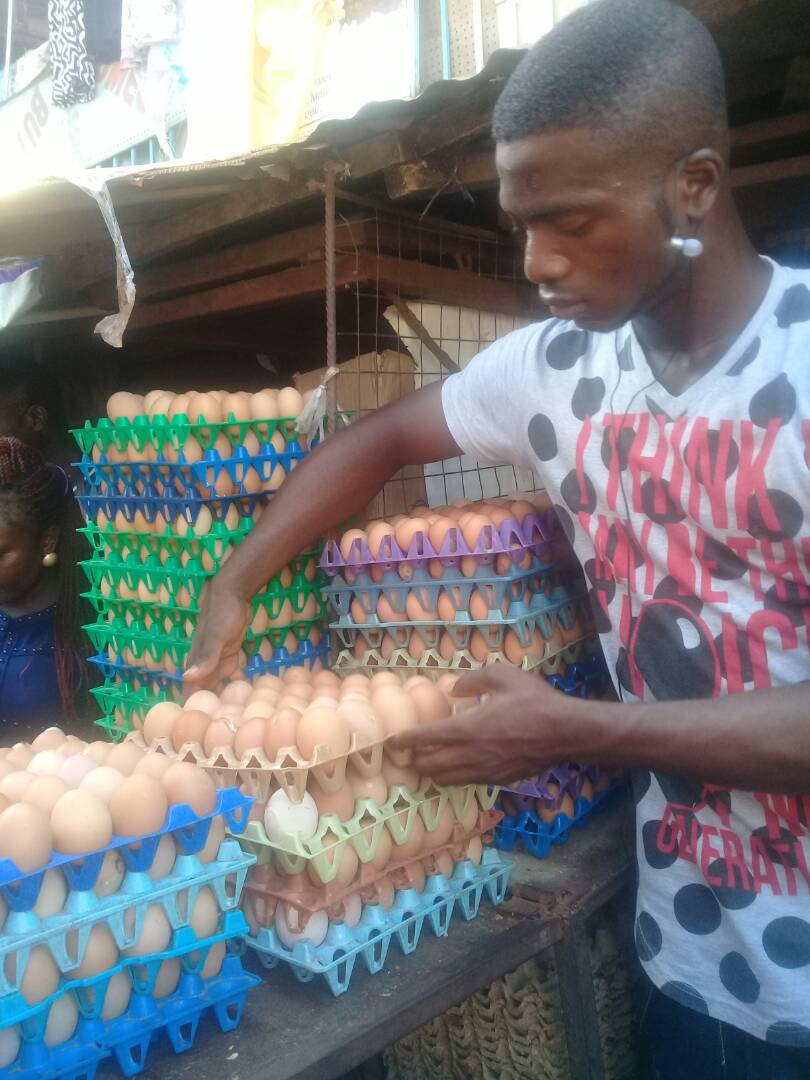
The programme has also helped poultry farmers such as Odogwu
Part of the key specifications of the programme is “to create a multiplier effect on the local economies in communities where the schools are located by boosting agriculture”. But how far has this been achieved since the inception of the programme?
Checks in the schools revealed that a good number of the caterers still use food items from outside the state in some instances.
For instance, the caterers in schools visited in Idemili north say they go to Onitsha market, one of the most popular markets in the state, to buy most of their food items including yam and rice. Further checks at the market which is located in Onitsha south LGA shows that most of the yams sold there are usually from the north, while the rice partly comes from Abakiliki, the Ebonyi state capital, and partly the Anambra home grown rice.
This notwithstanding, a few of the caterers such as the ones at Model Primary School, Nkwor Nnewi as well as Ezi Awka Community Primary School, Awka, told TheCable that they patronise local farmers for the native rice (Anambra rice) as well as local poultry farmers for the eggs used in cooking for the pupils.
At Nkwor Nnewi and Eke Awka, two of the most popular markets in the state, the poultry farmers selling eggs confirm the caterers had “at various times” bought eggs from them.
One of the sellers, Odogwu, says he has sold “about five crates of eggs to one lady that says she is using it to cook for school children” while another – Vincent Udoh – admits that although he hasn’t seen much of the caterers, “I once sold a crate to a caterer who asked for one to use and cook moi moi for pupils.”
Another trader at Nkwor Nnewi says she has supplied up to 50 tubers of yam in three different occasions to the caterer.
“Mostly I buy the yams from Onitsha although some of them are from the local farmers here,” she adds.
Excited pupils say the feeding has helped them
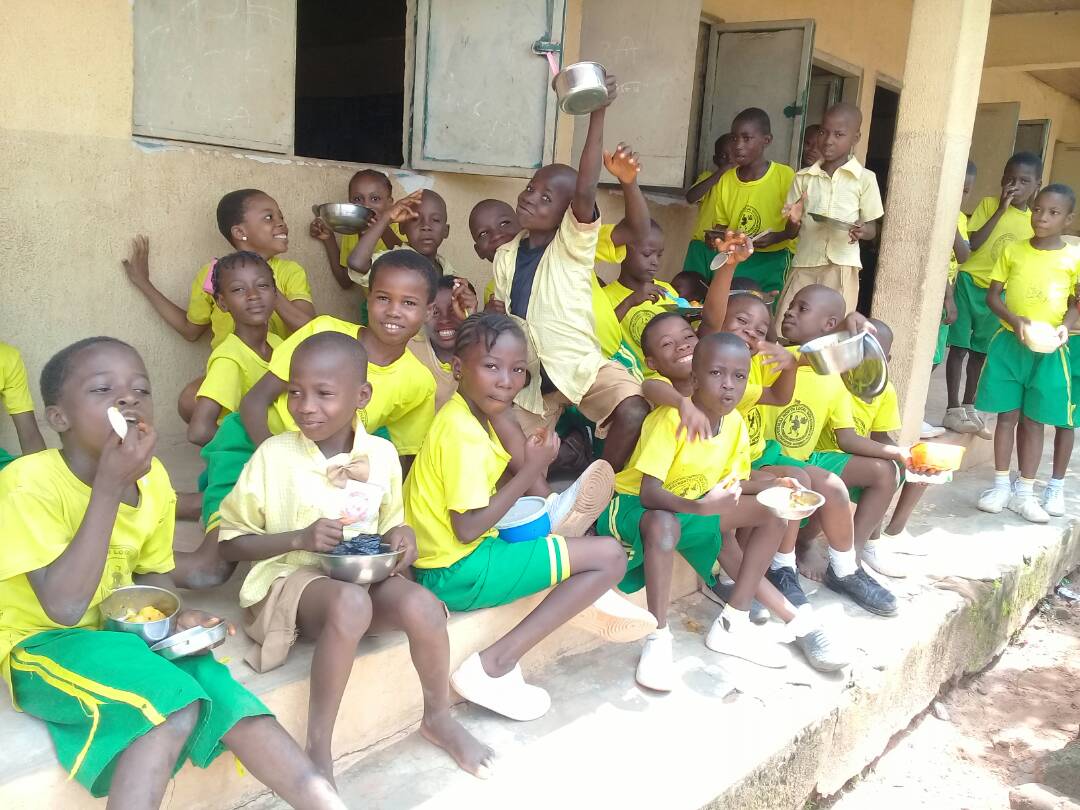
For the pupils, it is a thing of joy and happiness… days of missing school are over
At the center of the home grown school feeding programme lies the primary school pupils who happens to be the targeted beneficiaries. In what ways, then, have the roughly six months gesture brought joy to their lives?
Izuchukwu, a primary three pupil of Obosi, reveals that since the programme started, he no longer feels hungry during class.
“Sometimes if I don’t bring food to school, the one they give us helps me not to feel hungry.” Same line of thoughts with Nnamdi Okenwa, still a pupil in the school, who said the programme has brought him health benefits. “It makes me healthy and strong for studies,” the seven-year-old stated.
Also, Chiamaka, a primary two pupil of Nwafor Primary School in Awka says, in obvious shyness and excitement, that the food given to her has made her improve on her studies, adding that “I want to thank the government and to ask them to continue to bring food for us.”
On the list of beneficiaries of the school feeding programme are also the parents of the pupils who remain thankful for the reduced burden of expenses on them among other things.
Nnaemeka Agu, a parent whose ward is at Nwafor Primary School in Awka north LGA, says it has benefitted him as a father “in so many ways… most importantly, I have been able to save the money I normally give him for break in school.”
Also, Stella Okonkwo, whose child schools at Ezi Awka Community Primary School, Awka, talks about the how it has helped reduce the stress she usually goes through.
“Sometimes they have lessons and I usually don’t give my child food on daily basis for lessons, I try to return home early and cook what he will eat when he returns home and it is usually not easy but now, with the food they give them in school, I have more time to attend to other things,” she discloses.
There is also the challenge of calming the nerves of the nursery school pupils whenever the food is being shared to their primary school colleagues.
“Before the primary classes moved into the new block, then we were staying close to the nursery pupils, you see them hovering around the windows and doors when we started sharing the food. I really felt pity for them because they are even the ones that need it more,” said Udeh Comfort, a teacher at Obosi Central School.
A teacher at Ezi Awka Community Primary School observed that before now, some of the pupils do fell sick during school period. “When you ask him or her if they ate, they will say no. But we don’t witness such things again. By improving their health, it has also helped us in our work.”
Njideka Orji, a parent in the school, said it has helped improve her child’s learning capacity. According to her, “now when she comes home, she does her assignment very well and I have also seen some improvement in her result.”
With increased enrolment, the caterers are left with insufficient fund
After the pupils, the caterers come second at the focal point of the school feeding programme, reason being that they are the ones being charged directly to provide the food and so, by extension, calls the shots. But how satisfied are they really with how the programme is being run?
Quite a number of them feels aggrieved and believes handling the project is more or less a charity gesture on their part.
Helen, a caterer in one of the schools in Obosi, said the increased enrolment has made the job more challenging for them.
“Apart from the fact that the money paid is too small for the 106 pupils, nobody is talking about the daily increase in their attendance; despite that the money (N92,000 to each of the two caterers in the school) is still the same.”
Adorn in neat apron alongside her colleague, she goes ahead to give a clearer picture of the “hell” they are passing through: “the smallest ice fish you will see in the market now is N300 but what they gave us for fish is N50, N100. Rice is kept at N50 per cup; in the market, a cup is N150. So I don’t know, we are just in the hands of God. Beans now is N1600 a painter and we cook three painters for them. How is that going to be enough for the number of days we will cook beans with the little money they pay us?”
Similarly, Millicent Nkiru, another caterer at Umuota Nursery and Primary School, Idemili north, said the money given to them is “nothing to write home about.”
“At the end of the whole thing, there is nothing to go home with, because we are told government by the state it if from the feeding money that we will have our own income,” she lamented.
“A plate of the food, we are told, is supposed to be N60 but you will find out that it is nothing. How can you give a child just a piece of yam? If I am to cost a plate of food I give to these pupils, it is over N100. Normal tuber of yam is N500 and I am feeding 170 pupils.”
She added that most times, she adds takes from her stock as a caterer to supplement for what she has but “it is very wrong, it’s not supposed to be that way.”
Her claim about the price tag for each plate of food for the pupils however contradicts that of her colleague at Model Primary School, Nkwor Nnewi, who said they were told to keep a plate of food at N70.
“That N70 is for both the food, the firewood you will use in cooking, your workmanship… everything is included in the N70,” the caterer noted, adding, “when it started, an egg is N20 but now it is N50. The same thing applies for rice and other food items.”
Some caterers ‘squeeze out’ little money as their own compensation
At one of the schools visited, the principal admits that the caterers “manage to squeeze out a little from the money given to them for food.”
“Are they not human beings” she further queries, “they have to be able to cover up other expenses such as transport. The best way to stop such is for the government to be paying them, even if it is N20,000 monthly.”
A caterer in the school lends her voice to that of the principal as well: “If they want to do this kind of thing, it is good they bring out money and do it so it will make meaning.”
Another caterer in another school lamented how she once had to make up for the expenses with her money. “My husband was then asking, what kind of contract is this? I told him I believe they will still pay us, I will like to make the children happy.”
Food distribution: Well monitored in some schools, disorganized in others
In all the schools, same scene usually plays out before the caterers start sharing the food: on arrival at the school premises, they would usually proceed to the office of the school headmistress where the food is first tasted by either the health teacher in charge of the feeding at the school level or both the headmistress and health teacher; in some cases, the caterer joins in the ‘tasting’ galore as well – all to ascertain if the food is healthy for consumption.
While the usual time when the food is shared to the pupils is 11am – just before their break period – some other caterers come way behind schedule – like in the case of the caterer at Ezi Awka Community Primary School, who came at almost 12pm when the pupils were wrapping up their break period.
Meanwhile, in some of the schools, the distribution process is seen lacking in orderliness.
At Model Primary School Nkwor Nnewi, a two-storied building, the two caterers wait at the topmost floor – just opposite the headmistress’ office – while the pupils (some of whom their classes are downstairs – run their way up to get food. They would end up struggling for who gets to the “promised land” first.
“We’ve told them not to be rushing but they won’t listen,” said one of the teachers. “Carrying the food from class to class would be stressful since this is an upstairs.”
Amidst the struggle to go get their food, pupils from other classes usually end up joining them without the knowledge of both the caterer and the teacher monitoring the process. Jollof rice was on the menu on that fateful day and it ended up not reaching all pupils it’s meant for as some who peeped to see if the food was remaining grudgingly returned to their classes with their empty plates.
“Some of them intentionally come late for their food. They are told to come with their own plate to school but you see them waiting for others to finish eating so they can borrow their plate, that way they end up coming after others; then some nursery pupils may have joined and collected the share meant for them,” one of the caterers said.
NUT not in support of the school feeding programme
While the school feeding programme has been praised in various quarters in the state, the Anambra state chapter of the Nigerian Union of Teachers (NUT) says it is not in support of it.
Livinus Omini, the state secretary of the union, said this is because the union isn’t involved in running of the programme.
“We are not in support because it will not meet the expected societal objectives,” he added.
“We have not been involved and like I said, it has a political undertone. Why is it not in all schools, why is it not for all the pupils? We are not carried along.
“For me even as a unionist, our concern is with the teachers and education in general. But for you to have a successful implementation of any proposal or plan, you involve all those to be considered partners.
“It is politically motivated, that is why it is not in every state. Although it is going on here but it is not up to the expectation of any modern society. The food is not as meaningful as expected. So we call on the government to bring in all the necessary partners”
The state government speaks…
Chinwe Iwuchukwu, the coordinator of the programme in the state, told TheCable that the objectives of the programme as intended by the federal government have remained alive since its commencement in the state.
She also talked about the plans of the state government towards exploiting the opportunities presented by the programme.
“It initially started with 104,000 pupils but the number has increased by close to thirty percent,” she said.
“So now, you don’t have to force children to go to school. They actually look forward to going to school.
“It has also stimulated the agricultural sector. There is a ready market for the farmers. We have linked our farmers to the cooks and of course, our farmers are into cooperative.
“The state also has a long term procurement plan through the ministry of agriculture to ensure that regarding the programme. So we will to look into these things considering that prices are changing in the market, we have to get them some items at a subsidized rate.”
Although she couldn’t give the exact number of jobs created through the help of the school feeding programme, she added that apart from the caterers, the programme has been able to create employment for other parties involved.
“Like in the area of logistics management, there are a lot of things involved, moving the food items from the farmers to the caterers and then to the communities. When there is a programme like this, a whole lot of people are benefiting and not just the pupils.”
This is a special investigative project by Cable Newspaper Journalism Foundation (CNJF) in partnership with TheCable, supported by the MacArthur Foundation. Published materials are not the views of the MacArthur Foundation.















There are no comments at the moment, do you want to add one?
Write a comment